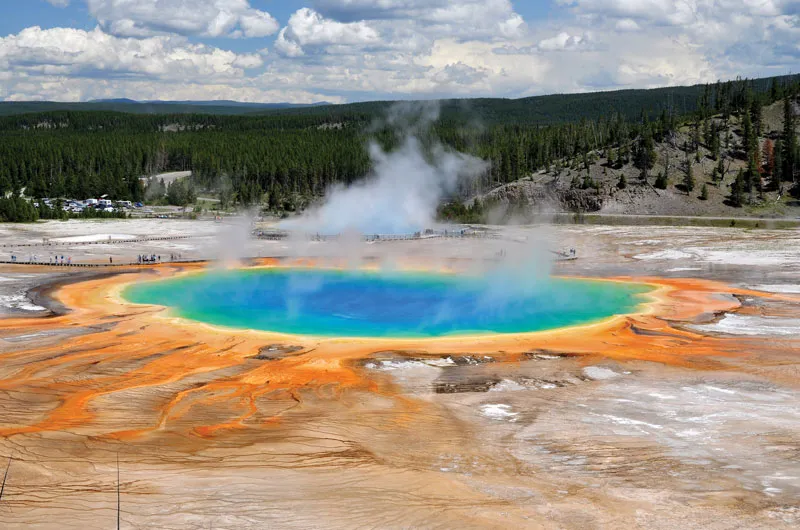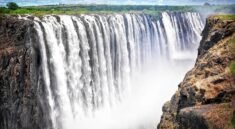
Yellowstone National Park is not just America’s first national park—it is the birthplace of the global conservation movement, a realm where volcanic forces, wildlife spectacles, and pristine wilderness converge in one of the most awe-inspiring natural environments on Earth. Straddling the states of Wyoming, Montana, and Idaho, Yellowstone spans over 2.2 million acres, offering visitors a kaleidoscope of natural wonders—exploding geysers, roaring waterfalls, expansive meadows, and the chance to see wild animals roaming freely, as they have for centuries.
Whether you’re marveling at the legendary Old Faithful geyser, watching a grizzly bear cross the Lamar Valley, or hiking past steaming hot springs under open skies, Yellowstone is more than a destination—it’s a living, breathing, and sometimes erupting geological masterpiece that invites you to rediscover your connection with the Earth.
A Park Born From Fire and Vision
Established in 1872, Yellowstone became the world’s first national park, thanks to the efforts of explorers, conservationists, and forward-thinking politicians who believed that such unique natural beauty should be preserved “for the benefit and enjoyment of the people.” Its protection marked the beginning of the national park system, a model now adopted around the globe.
At the heart of Yellowstone is a supervolcano, whose immense underground magma chamber has shaped the park’s extraordinary geothermal features. The landscape, carved by ancient lava flows, glacial movement, and tectonic uplift, provides a rare glimpse into the Earth’s raw power—and its breathtaking beauty.
Geysers and Geothermal Marvels
Yellowstone is home to more than 10,000 hydrothermal features—more than anywhere else on the planet. These include:
- Over 500 geysers, including the world-famous Old Faithful, which erupts every 60 to 110 minutes, shooting water over 100 feet into the air.
- Colorful hot springs like the Grand Prismatic Spring, the largest in the U.S., with vibrant bands of orange, yellow, and blue caused by heat-loving bacteria.
- Mud pots that bubble and belch with a mixture of acidic water and volcanic gases.
- Fumaroles, or steam vents, that hiss like pressure cookers in the wild.
The Upper Geyser Basin, where Old Faithful resides, is the most accessible place to view these features, but areas like the Norris Geyser Basin (home to Steamboat Geyser, the tallest active geyser in the world) offer dramatic, less-crowded encounters with nature’s thermal fury.
Wildlife Wonderland
Yellowstone is one of the few remaining ecosystems in the temperate Northern Hemisphere where predators and prey coexist as they once did. The park supports:
- Bison: Yellowstone boasts the largest free-roaming herd of bison in the U.S. Watch them graze in Hayden Valley or cross snowy roads in winter.
- Wolves: Reintroduced in the 1990s, wolves have restored ecological balance and can be seen—if you’re lucky—in Lamar Valley at dawn or dusk.
- Grizzly and black bears: Spotted near Yellowstone Lake, meadows, or forested slopes.
- Elk, moose, bighorn sheep, and pronghorn: Grazing throughout the valleys and river corridors.
- Birdlife: Including bald eagles, osprey, trumpeter swans, and peregrine falcons.
Bring binoculars and patience—wildlife watching in Yellowstone is about slowing down, staying alert, and respecting that you’re in their territory, not the other way around.
The Grand Canyon of Yellowstone
One of the most dramatic and photogenic spots in the park is the Grand Canyon of the Yellowstone River. Carved over millennia, this canyon features stunning layers of yellow, red, and pink rock, shaped by volcanic heat and erosion.
Highlights include:
- Lower Falls: At 308 feet tall, it’s nearly twice the height of Niagara Falls and is the most photographed waterfall in the park.
- Artist Point: A famous overlook with postcard-perfect views of the canyon and falls.
- Uncle Tom’s Trail: A challenging but rewarding hike that descends into the canyon via stairs and platforms for an up-close look at the Lower Falls.
- North and South Rim Trails: Scenic walks along the edge with panoramic vistas.
Lakes, Rivers, and Waterfalls
Beyond geysers and canyons, Yellowstone offers serene landscapes of water and reflection. The massive Yellowstone Lake sits atop a volcanic caldera and is one of the largest high-elevation lakes in North America. In summer, its shores are perfect for picnicking, kayaking, or spotting otters and pelicans.
The Yellowstone River, the park’s lifeline, meanders through valleys and gorges before cascading into its famous falls. There are also more than 290 waterfalls across the park, including:
- Tower Fall: A 132-foot waterfall framed by towering volcanic spires.
- Gibbon Falls: A roadside waterfall that’s accessible and breathtaking.
- Mystic Falls: Reached via a short but scenic hike in Biscuit Basin.
Lamar Valley and Hayden Valley: America’s Serengeti
These vast, open valleys are two of the best places in Yellowstone for wildlife viewing and photography. Nicknamed “America’s Serengeti,” Lamar Valley in the northeastern corner of the park is a haven for bison herds, elk, bears, and wolves.
- Early mornings offer the best chances to see predators.
- Bring a spotting scope or join a ranger-led wildlife tour.
- Pull over at designated viewing areas to watch animals from a safe distance.
Hayden Valley, located between Yellowstone Lake and Canyon Village, is another top spot for observing bison, especially in spring when calves—nicknamed “red dogs”—are born.
Hiking and Outdoor Adventures
Yellowstone offers over 900 miles of hiking trails, from short boardwalk strolls to multi-day backcountry treks. Popular day hikes include:
- Fairy Falls Trail: A moderate hike leading to a 200-foot waterfall and views of Grand Prismatic Spring from above.
- Mount Washburn: A high-altitude trail with sweeping views, wildflowers, and bighorn sheep.
- Mystic Falls Loop: A mix of thermal features and wooded serenity.
- Avalanche Peak: For experienced hikers, this strenuous trail rewards with 360-degree alpine views.
Other activities include:
- Camping: With 12 campgrounds and numerous backcountry sites.
- Fishing: In designated areas with a Yellowstone fishing permit.
- Horseback riding: Available through authorized outfitters.
- Snowshoeing and cross-country skiing: In winter, when much of the park becomes a frozen wonderland.
Seasons of Yellowstone
Each season in Yellowstone offers a distinct experience:
- Spring (April–June): Melting snow reveals green meadows, and animals give birth to their young.
- Summer (July–August): Most facilities and roads are open; best for hiking and family vacations.
- Fall (September–October): Vibrant foliage, bugling elk, fewer crowds.
- Winter (November–March): Snow-covered silence, ideal for wolf tracking, wildlife photography, and seeing geysers steam in the frigid air.
Winter visitors can take guided snow coach tours or explore from nearby gateways like West Yellowstone.
Gateway Towns and Park Entrances
Yellowstone has five main entrances, each offering access to different areas:
- West Entrance (West Yellowstone, Montana): Closest to geysers and Old Faithful.
- North Entrance (Gardiner, Montana): Open year-round; near Mammoth Hot Springs.
- Northeast Entrance (Cooke City, Montana): Gateway to Lamar Valley.
- South Entrance (Jackson Hole, Wyoming): Links with Grand Teton National Park.
- East Entrance (Cody, Wyoming): Scenic drive through Absaroka Mountains.
Each entrance is serviced by charming towns with lodges, museums, restaurants, and outfitters, making them great bases for exploration.
A Conservation Success Story
Yellowstone is a model for ecosystem restoration and wildlife conservation. The reintroduction of gray wolves in 1995, once controversial, has helped rebalance predator-prey dynamics, improve river ecosystems, and generate new scientific insights.
Ongoing efforts protect native fish, reduce invasive species, and manage bison populations while respecting Native American treaties and traditions.
Visitors are encouraged to “Leave No Trace”, stay on boardwalks near thermal features, and maintain respectful distances from wildlife to ensure the park remains healthy for future generations.
Why Yellowstone Still Captivates the World
There is no place on Earth quite like Yellowstone. It is:
- A geological theater, where the planet reveals its fiery soul.
- A wildlife haven, where creatures live as they did before modern boundaries.
- A refuge of silence and stars, where you can feel small and infinite at once.
- A place of learning and legacy, where the values of conservation were born.
Whether you come to hike its trails, photograph a bison at sunrise, or stand in awe of a geyser erupting against a snow-capped sky, Yellowstone will stir your soul and awaken your sense of wonder.




